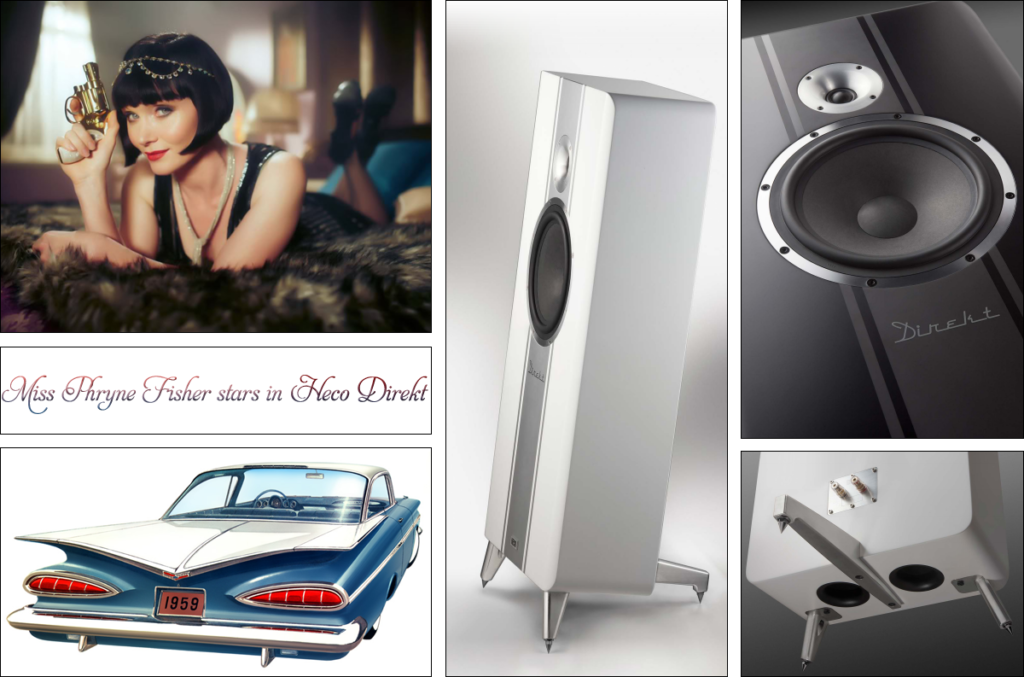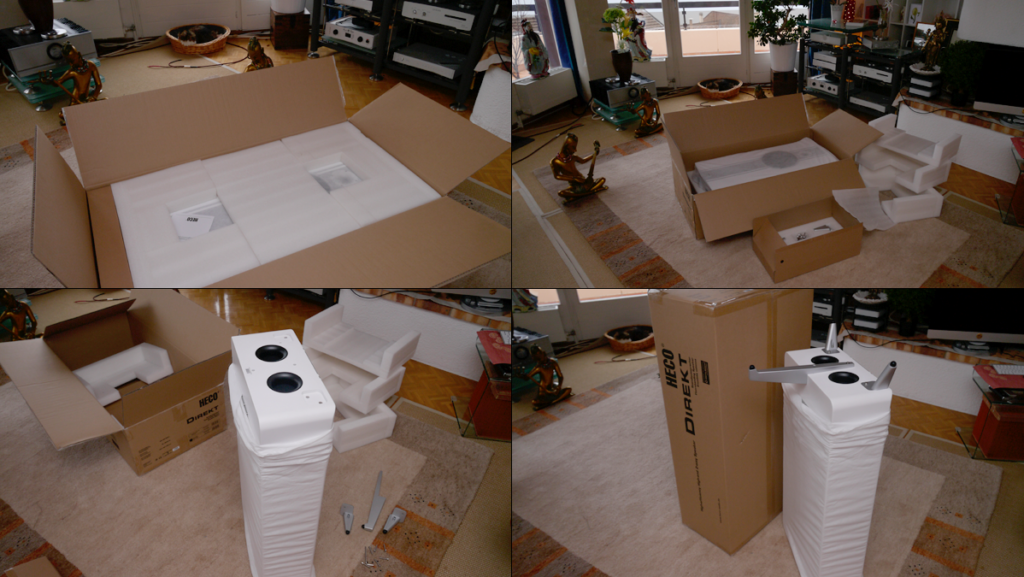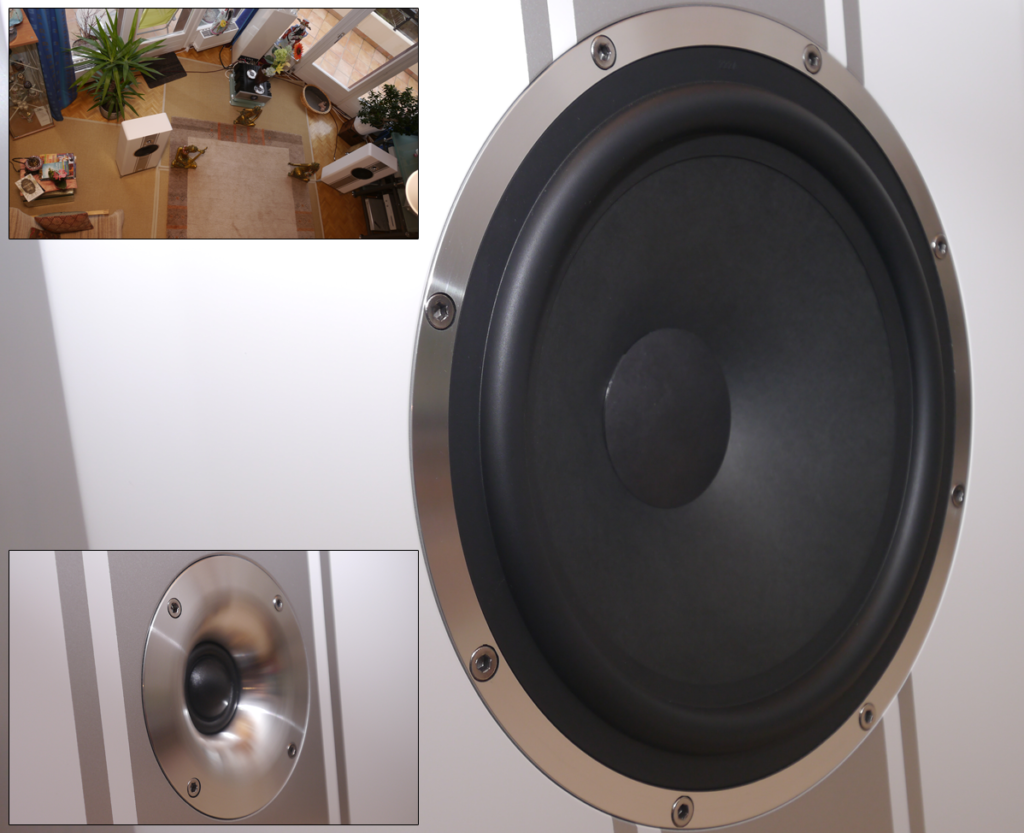Heco Direkt 6moons.com Review

Once upon a time, cars had fins. Their tyres flaunted white walls and spokes. Gals were dames, guys proper gents. Loudspeakers were properly broad-shouldered Tonmöbel. Then plastic surgery happened; and the world hasn’t been right since. Now even teenagers get nipped, tucked and cut. Speakers are skinny but inefficient. Midranges are small metallic high-excursion wonders. Tweeters do beryllium, magnesium or diamond. Shiver. Oy!




Some do protest; but perhaps not enough. Think John DeVore’s Orangutan models. Those cost a pretty penny. Germany’s Heco Direkt want €3’000 for the twosome. They combine an 11″/280mm paper mid/woofer with a 1.2″/28mm dual-magnet soft dome. That—tack down your Borsalino—nets 95dB sensitivity. Funkin’ hey? Loud and clear. Viva la retro. Hello 300B, FirstWatt, Bakoon & Bros.
Check out the dims. These turn around the narrow-in-front, deep-on-the-side recipe. They measure 40cm wide, 20cm deep and just 90cm tall. Two down-fire ports deal with a precisely fixed thus calculated boundary. No guess work with front or rear-firing bores involved. Response claims 25 to 28’000Hz reach. In a nod at modernity whence Oak no longer spells chic but passé, finish options are black on black or white on white. ‘On’ refers to the vertical speed stripe bisecting the fascia. Three silvery metal footers do the unshakeable tripod thing. They also lock in their designer’s desired backward rake. A deep metallic tweeter waveguide and matching mid/woofer trim ring complete the 2-tone thematic. Construction is MDF with internal bracing. There are even circular driver covers to keep peace with the ladies… er, dames.
It goes without saying that valves may apply. Perhaps even 2A3 non-paralleled SET though 45 may be pushing it. The Direkt is more retro than just cosmetics. It’s a deliberate retro load as well. And on appearances at least, one expects bona fide retro sonics even from transistors. Just look at that slightly larger tweeter and hunky midrange. There’s something about tone, pressure and density which 3-inch mids simply won’t do, no matter the most hi-tech of diaphragm materials like graphene or coated ceramics. Only big paper has that number. Call ya?
That broad baffles can’t soundstage is pure myth, too. So is the belief that it takes more than two quality drivers to cover the audible range. Arguments can be made for all manner of designs of course. There’s a reason and season for everything. When it comes to basic necessities, it’s simply the case that a big-woofer’d two-way like they used to make will be all that most people really need.

Wannabe or true modern classic? If you’ve wondered just how high Heco get on their big Kraft paper driver, it’s 2’350Hz. Before you confuse their Kraft paper with generic brown parcel wrapping paper, “only Nordic pine timber has the required strong fibres. Due to their low strength, other woods and cheaper waste papers are excluded. Our pulp gets mixed with 5% German-produced 6-12mm long wool fibres. During this process, all the fibres interlock into a densely conjoined weave. This mix is then pressed evenly and under high pressure into the conical cone shape. This creates a strong diaphragm with the desired acoustic properties for high mechanical loading.”
So the Direkt promises not just vintage tone if with very modern bandwidth, it hints at a grown pair of dynamics. The Germans write that even a 10-watt tube amp is willkommen. Insisting on a fully preconditioned pair for this review, Heco said that it’d only take them a few days to make it so. For buyers who must do it themselves, there’s no endless wait to a happy ending. Phewntastic!
Regular readers know that our top-floor flat on the hill means navigating three flights of outdoor stairs. It’s where all couriers drop off shipments. Whilst a blessed elevator takes over from the end of the foyer once boxes are on the landing, if I can’t physically manoeuvre a load up the steps by my lonesome, my auditions are restricted to the garage where there’s not a single power outlet. Needless to say, I’d ticked off the ‘can do’ box when I’d looked up today’s 25.8kg beforehand. On size and elbow grease, the Direkt is a friendly chap.
But does it foam at the surround? As reader and occasional contributor Michel Surdi queried, “that’s a timely review for sure. But please don’t forget to tell us what the woofer surrounds are made of. It doesn’t look like pleated cloth so I fear for foam!” I told our man not to diss foam. Modern foams have come a long way from their vintage kin which hated UV and tended to crumble after a few years. Today Voxativ for example started with goat-leather surrounds, then transitioned to foam not because they’re cheap bastards but because it sounded better. With ultra-efficient drivers, shaving even a gram off the moving mass matters. Moving mass is the totality of the displaced assembly: cone/dome, surround, spider, voice coil. Foam is very light. Also, high efficiency reduces excursion requirements. Lowthers for example do ±1mm. That’s perfect for a foam surround. Contrast that to subwoofers. With heavy cones, they’re inefficient. That’s compensated by cheap high-power class D plate amps; and big excursion potential from beastly rubber-roll surrounds.

To my eyes, the stock Heco photos suggested butyl rubber. But I promised Michel to check it out closely when my pair arrived. He’s spot on that vintage paper drivers of high efficiency used either pleated cloth or foam surrounds. For magnetics, they routinely favoured Alnico. Heco even do that for their top dedicated midrange unit. And, they exploit Klippel diagnostics during driver R&D to harvest from modernity what it has to offer their general retro-inspired approach. For this driver, did it mean modern rubber or Surdi’s dreaded foam? Before our retro meme feels like a lame hashtag, consider that Heco have been in business for six decades – since 1949 to be precise. In this sector, that’s about as vintage as it gets. Jawohl!

Business manager Shandro Fischer of the VOXX Group [above]—this group includes the Magnat brand—identifies three vintage 10″ two-ways he remembers with fondness: a Siemens Klangfilm box from the 60s; a Lansing from the 70s; and a Technics from the 80s. Designer Christian Gather [below] meanwhile was working on a speaker in the high-efficiency big-woofer 2-way genre for himself. Then synchronicity aligned.

His prototype won the eventual green light as a formal Heco production model which launched a year later at Munich HighEnd 2015. The Direkt is a nominal 6Ω load which doesn’t drop below 4Ω. However, the ports create a 22Ω spike at 28Hz and a 23Ω peak at 70Hz. That’s where low-impedance transistor outputs, possibly preceded by a tube linestage like in the Magnat RV3 shown, could have the edge over pure tubes.

As the right photo shows, once the metal footers are bolted on—those ship disassembled—the speaker hits an average man at about the belt line. And if you hadn’t yet made the connection, the two drivers in it were purpose designed, the big ‘un just for this model. They’re not off-the-shelf generics from some catalogue but custom. That speaks to Heco’s in-house resources.
My company contact Meruert ‘Meru’ Zimmer with her magnat.de email suffix announced delivery by DHL. Arriving crisscrossed with Magnat-branded tape on its black shrink wrap for the single pallet, the shipment reiterated how these two marques are joined at the hip. Easily fitting both boxes into the elevator with plenty of room left for this operator, unboxing showed thick 2″ foam pieces cradling the speakers from all six sides. Attaching the flawlessly machined metal footers via 6 bolts with the provided 5mm hex key was obvious child’s play. Termination options were spikes or hemispherical rubber tips. Given hardwood floors in a rental, I used the latter. Wiring up by single terminals and checking on the volume setting of the Nagra Jazz preamp immediately confirmed rather higher than usual sensitivity.

Michel and fellow foam funkers will sleep easy knowing that the big driver surrounds are butyl rubber. Haters of reflective gloss finishes like yours give two thumbs up for Heco’s matte finish which is far easier on finger prints, dust and high maintenance. Despisers of sharp edges applaud not only the profile’s round corners but the slightly curved transitions between vertical edges and cheeks; and fine roundovers elsewhere. Given that the Direkt is a box with three sets of parallel walls, not a trendy wind slippery boat-hull affair, our Germans from Pulheim have craftily shaved off bits of material here and there to soften their rectangulosity. In the finely painted MDF flesh, actual cosmetics were even more attractive than the photos had promised.

Whether the efficiency promise kept faith with low-power tube amplifiers relative to impedance swings and phase angles would be sorted with a 6V6 push/pull integrated from Russia’s S.A.Lab whose power rating mirrors a standard 300B SET. I’d also acquired a twice-as-powerful 6L6 15/30wpc into 8/4Ω specimen from the same designer scheduled to land by the end of the month. For a base line of what the Direkt could do, I’d of course start with our beastly 30wpc Pass Labs XA30.8. That actually does 90 watts of pure class A into 8Ω before THD hits a nominal 1%. That’d let me know what, if anything, the tube amps left under the table. Game on.
Listener, know thyself. Then instinctual reactions paint a quick picture. Of course it’ll be subjective but still can prove to have surprisingly consistent implications. Do you find yourself pulling out your biggest baddest bombast to go on a symphonic/soundtrack binge? Do you pursue small intimate slow numbers to draw you into a zone of reverie? Do you go after virtuoso how-many-notes-in-a-bar fare? Are you in critical observer mode to notice stuff left, right and centre? Are you in uncomplicated immersion without internally ticking things off? Do you play loud or sotto voce? Electronica or acoustic? Such questions could break down into quite the list depending on listener. From my early reactions, I quickly understood that the Direkt was no HD speaker. It was a real MFer: not a high-definition number but about more fun. How so? It didn’t edge-limn the virtual stage in holographic focus. It created no performer haloes of illuminated venue reflections. It didn’t do a number of special ultra-contrast effects. It put me in easy listening not critical observer mode. The latter notices things against a constant reference. Maintaining said reference creates distance. With it comes a certain measure of abstraction or aloofness. On the other hand, no distance, no watcher. Things aren’t noticed, they just are. With immersion, one partakes instead of judging, comparing or measuring. And the Direkt triggered such immersive involvement, not the critical faculties.
It sounded big, meaty, relaxed and easy. It wasn’t nearly as dialled for punch and shove as had been the hard-hung Zu Druid V which share with our Germans the general 11-12″ two-way concept plus hornloaded tweeter. If the Direkt were a tyre, it wasn’t as inflated. It proved completely non-fatiguing even on tracks which on high-resolution speakers betray heat or brightness. The obvious body-building aspects of its 11-inch Kraftwerker handling even dainty vocals meant that thinner more nervous productions filled out noticeably to come across chunkier and more chilled. Soundstaging was panoramic as usual but within in, separation and layering were medium not high. The Direkt made ordinary tonally compromised recordings sound better. Then it embraced them at higher levels without backfiring like a Judas flinter. That’s a sneaky reference to Jonathan Gash’s first Lovejoy novel, about a dead collector of antique flintlock duelling pistols. One of these guns had been intentionally designed to kill whoever fired it. Thus it insured that the dueller’s opponent would always win.
Meanwhile top recordings didn’t sound as spectacular as they do on true high-definition speakers like our EnigmAcoustics Mythology 1. That was the price which the Direkt exacted for its retro treatment. That live music never matches hifi spectaculars on soundstage exactitude, transparency or airiness is an old hat. Just so, for many, such FX become a reference whereby ‘realism’ or at least audiophile desirability are judged. If you’ve seen through that lie to neither expect it nor fault a speaker for not telling it, the Direkt could be talking to you. It’ll help you rediscover non-audiophile fare at robust SPL and enjoy it a lot more.

If from the above you triangulate back to think that I probably found myself listening to many lesser productions at stouter levels, quite. All the usual off-limits stuff that gets short shrift or no play because sonic woes overshadow musical significance was fair game. My guilty pleasures included assorted Arab Pop from singers whose voices I love; like Fi Hadret El Mahboub by Wael Jassar. As such, the Heco Direkt was a heckler of a reminder. Unnatural resolution—that is, resolution ratcheted up well beyond what’s normal ‘in the wild’ of live venues—is mostly counterproductive to musical enjoyment. Whilst top productions do benefit, a vast swath of popular music suffers. And what is popular music if not music which millions of people love to listen to? Heck, there must be very good reason why audiophilia is such a fringe pursuit. It does very little for popular music. For the Direkt, it means prioritizing tone, density and dynamics and in that sequence; and touching upon but not specializing in micro detail and separation. In my book, that doesn’t make it a low-resolution speaker at all. It’s a speaker with perfectly natural resolution. Music sounds big, bold and easy, not small, excessively sorted and fussy. With the basics sorted, it’s time for the hardware shuffle to compare and contrast.
To facilitate convenient A/Bs against the Russian amp with pot, I left the Nagra Jazz preamp in the loop. I simply set it to 0dB gain to act as an actively buffered passive of sorts. This drove the XA30.8 balanced; and the S.A.Lab Blackbird single-ended. The latter’s volume control was fully open, hence bypassed. For standard SPL, the Nagra’s volume sat at 10:00 o’clock, meaning a full 30dB below unity gain (the fixed output voltage of the Aqua Hifi LaScala MkII DAC). Yousa. If you hadn’t figured it out yet, 95dB in-room speaker sensitivity has loud and clear benefits. In our 100sqm listening space, I had headroom galore for all civilized and even raunchier purposes – with an 8/15wpc into 8/4Ω valve amp. Being of the push/pull sort to cancel most 2nd-order THD of equivalent 300B SET, the Blackbird lacks their octave-doubled fuzz. Its softness belongs to the temporal horizontal domain of melody not rhythm. It’s more fluid, elastic and pliant than the Pass transistor amp. With the Direkt’s virtual suspension more softly sprung than a sports car, the combination was fantastically redolent and tonally generous. Tube lingo would call its colour palette saturated. I’d sign off as long as one subtracted from it the humidity and blur of no-feedback single-ended triode behaviour. The Blackbird’s climate isn’t tropical but moderate. Its low-bass definition and impact meanwhile fell behind the XA30.8 where the vintage 6V6 bottles gave up some grip and reach. Here the higher power and current delivery of the Mosfets had the aces. That was little surprise given that into the speaker’s 22/23Ω port peaks at 28/70Hz, most amps deliver a 1/3rd or less than they do into 8Ω. If the 8Ω rating be excessive for this application, no problem. If not, those bands in the low and mid bass will attenuate and dynamically compress. If Heco wanted to really welcome low-power tube amps all around, they’d need to linearize their impedance plot with many more crossover parts.

On Mercan Dede’s superbly recorded Nefes, the Direkt’s natural resolution left things under the table relative to soundstage holography, depth of stage and very high recorded image specificity, i.e. aspects of deliberate studio trickery to achieve sonic HD. Dede is an expert DJ and producer whose canon of Sufi-inspired ambient albums sets up vast soundscapes in which experts on acoustic instruments commingle with his synths and faux acoustics. By prioritizing tone and density, the Direkt gave less attention to audible space. On fare with this calibre of spaciousness, it clearly flipped the ‘I’m there’ perspective to ‘they’re here’. Instead of feeling transported into an acoustic other than ours—here one that’s deliberately enormous but very precisely mapped—the performers materialize in your digs stripped of surrounding context: meat without the sizzle. Here the hornloaded soft dome tweeter didn’t shed additional light as might be expected. The wave guide’s primary sonic contribution seemed to be a smoother radiation transition. By the same token, massed strings didn’t show as many defined upper harmonic ‘white caps’ to demonstrate their multitudiousness within the general sea. Cymbals and triangles sounded mellower and heavier. I’m sure you can do the math. Again, payback came as lower fatigue factor and a friendlier rendering of bright hot recordings. Once more also, the lateral expanse of the virtual stage was just as broad as usual. It’s primarily determined by how wide or narrow you place your boxes.
Depth is likewise influenced by front-wall distance but other things factor as well. Here the Heco staged more shallow as though the rear stage lights were dimmed. With mellower transitions and lower recorded reflections—I heard far less of that pixilated faux reverb trailing Wael Jassar for example—what happened within the borders of the stage focused softer. This same gentler less illuminated focus also meant that images were bigger if a tad more ambiguous. In the immortal famished words of ex contributor Chip Stern, this was comfort food à la meat, potatoes and gravy, not some overpriced food paintings on plates in a swanky bistro that still have you hungry afterwards.

Contrasting Heco’s version of a higher-eff speaker to a super-eff specimen like Voxativ or Rethm would net big offsets. Their smaller widebanders have far more presence-region energy and insight, higher microdynamic jump, more expansive aerated spaciousness and they come on song like true hifi whisperers, i.e. sooner. In trade, they’re tonally leaner, texturally more striated and far more brutal on mediocre recordings. They’re seriously more critical of ancillaries and nearly invariably favour specialty valve amps. Heco’s Direkt is far more of a fair-trade partner or equal-opportunity employer. If anything, it should favour transistor amps. Where the 100dB+ brigade are champs of the micro realm both dynamic and detail, the Heco look after the macro. They go loud very willingly and without putting even a toe forward into the screechy and edgy. They’re big-iron V-twin cruisers, not 11’000RPM red-lining whiny crotch rockets. Because of it and their price, they’re perfect for owners of affordable 50wpc integrateds or even receivers. Great matches would be the original €629 Clones Audio 25i and the now discontinued €3’000 FirstWatt F5. Whilst I loved the Direkt optics particularly in the two-tone white, Ivette was thoroughly unimpressed. She found them far too “old looking”. When I confirmed that retro was indeed the whole point, she agreed that retro had been attained; in full. She just didn’t like them any better for it. Appearance will probably be divisive. For what I view as the main audience, it could be a real asset however. After all, when the air-guitar axe man cometh, who’d fail to make the connection?
From my descriptions, you’ll have already figured that the Direkt could be a most excellent accelerant candidate by way of more incisive upstream kit. That it’s never the cost of the gear which wins best sound but maximal cooperation between various hardware will be perfectly obvious to our readers. Something far less costly can become our version of ‘work smart not hard’. To tune into that tune meant the COS Engineering D1 DAC/pre into the Clones Audio chip monos where minimal circuitry ends in nasty op amps for actual output devices. Those obnoxicators obviously aren’t nasty at all. In fact, they’re most effective. But, they do offend the discrete snob police. Whilst gain clones can save big, they’re major losers in the audiophile cred stakes. Burson for example have built an entire brand by demonizing op amps. And for the money, their stuff does sound very good indeed. It’s simply not the only way to—tears alert—peel that onion.

To poke the snobs a bit more, I parked each compact 50-watt poseur atop one of the big amps to rile by ridiculous contrast. With zero valves in the signal path and feistier brisk operational amps on the speaker inputs—the 55pm pair sells for €899—I now made the best sound from my hardware inventory. Speaker cables and interconnects were redlevel Lupo from Chris Sommovigo’s Black Cat Cable line for another budget buster sighting. I bet that Funjoe’s integrated run off the Metrum Hex would have been every bit as good and saved even further cashish. No matter, now the Direkt was more direct and explicit, the bass truly righteous with more snarl and wiriness when mandated and HF effects given more attention. Sitting down during lunch, my wife remarked that surely I had our big Zu Submission on. I did not. It clearly had become superfluous.
What Heco present with their Direkt is a Snell/AudioNote related box that looks a lot better, costs rather less and as described, tangos beautifully with even affordable transistor gear, no glow worms required. If you like your sonics taut, jumpy, punchy and illuminated, I’d in fact go pure transistors. There’s so much natural tone and density built into the Direkt that electronics can be picked which put the foot on the gas and flip the soft top open to let the light in. Such electronics also put more air into the tyres to effect a sportier ride.

To Direkt your attention where it matters most, I’ll close out by saying that this Heco is an eminently friendly speaker. It’s beautifully made for a fair price and in two distinctive finishes. It needs very little power to sing. It eliminates a subwoofer. And pretty much no matter what, it is genetically incapable of turning tiresome and fatiguing. It’s no fuss pot or diva. Even in the sense of turning its broad back on modern ultra resolution with its unhealthy selectivity on what gets play time and what doesn’t, the Direkt goes retro(grade). Easy does it. What a lovely break from the norm all around. If I were a dealer, I might inquire whether Heco allowed single-model representation. This one would fill a gap which most dealerships suffer just because. And if I were a punter counting my coins with the Direkt in my crossed hairs not wires, I’d hop onto the Clones Audio website to investigate their gain-clone offers. Not only don’t you need any more with these… you’ll likely do worse elsewhere.
0 Comments